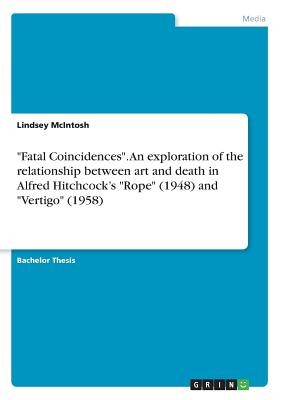
- We will send in 10–14 business days.
- Author: Lindsey McIntosh
- Publisher: GRIN Verlag
- Year: 2017
- Pages: 32
- ISBN-10: 3668433038
- ISBN-13: 9783668433038
- Format: 14.8 x 21 x 0.2 cm, minkšti viršeliai
- Language: English
- SAVE -10% with code: EXTRA
Fatal Coincidences. An exploration of the relationship between art and death in Alfred Hitchcock's Rope (1948) and Vertigo (1958) (e-book) (used book) | bookbook.eu
Reviews
Description
Bachelor Thesis from the year 2014 in the subject Art - Photography and Film, grade: A, University of Strathclyde, language: English, abstract: The principle objective of this essay will be to explore and explicate the relationship between art and death within two films by Alfred Hitchcock: Rope (1948) and Vertigo (1958). Discussing Hitchcock's filmography in 'Saying it With Pictures', Erik S. Lunde and Douglas A. Noverr credit the influence of art to be of paramount importance to the director's visual form, remarking that 'a great interest in the fine arts strengthened the cinematic vision displayed in countless brilliantly conceived photographic images in his films' (Loukides and Fuller 1993, p.97). Both critics trace an admiration for the classical arts to have flourished in the director's youth as he immersed himself in painting classes during his time at the University of London (Ibid). Later in life, art would assume a strong place within both Hitchcock's personal and professional personas; within his private sphere Hitchcock accumulated interest in original works of art, collecting pieces by artists such as Paul Klee, Auguste Rodin and Salvador Dali. Professionally, a fascination with the visual arts would infiltrate his body of work, with portraits, paintings and sculptures featuring predominantly within the majority of his films. [...] As part of centenary celebrations of the filmmaker's work, a unique visual exhibition was unveiled to commemorate the intimate relationship between art and Hitchcock films. Opening in 2000, an exhibition titled 'Hitchcock and Art: Fatal Coincidences' opened in the Montreal Museum of Fine Arts. Captioned as a 'celebration of Hitchcock's personal creative expression' (Moral 2002, p.171), 'Fatal Coincidences' was designed by Guy Cogeval and Dominique Paini to feature over two hundred artworks spanning across the previous two centuries, depicting familiar scenes of art echoed within Hitchcock's own body of work. Whilst the e
EXTRA 10 % discount with code: EXTRA
The promotion ends in 21d.02:22:06
The discount code is valid when purchasing from 10 €. Discounts do not stack.
- Author: Lindsey McIntosh
- Publisher: GRIN Verlag
- Year: 2017
- Pages: 32
- ISBN-10: 3668433038
- ISBN-13: 9783668433038
- Format: 14.8 x 21 x 0.2 cm, minkšti viršeliai
- Language: English English
Bachelor Thesis from the year 2014 in the subject Art - Photography and Film, grade: A, University of Strathclyde, language: English, abstract: The principle objective of this essay will be to explore and explicate the relationship between art and death within two films by Alfred Hitchcock: Rope (1948) and Vertigo (1958). Discussing Hitchcock's filmography in 'Saying it With Pictures', Erik S. Lunde and Douglas A. Noverr credit the influence of art to be of paramount importance to the director's visual form, remarking that 'a great interest in the fine arts strengthened the cinematic vision displayed in countless brilliantly conceived photographic images in his films' (Loukides and Fuller 1993, p.97). Both critics trace an admiration for the classical arts to have flourished in the director's youth as he immersed himself in painting classes during his time at the University of London (Ibid). Later in life, art would assume a strong place within both Hitchcock's personal and professional personas; within his private sphere Hitchcock accumulated interest in original works of art, collecting pieces by artists such as Paul Klee, Auguste Rodin and Salvador Dali. Professionally, a fascination with the visual arts would infiltrate his body of work, with portraits, paintings and sculptures featuring predominantly within the majority of his films. [...] As part of centenary celebrations of the filmmaker's work, a unique visual exhibition was unveiled to commemorate the intimate relationship between art and Hitchcock films. Opening in 2000, an exhibition titled 'Hitchcock and Art: Fatal Coincidences' opened in the Montreal Museum of Fine Arts. Captioned as a 'celebration of Hitchcock's personal creative expression' (Moral 2002, p.171), 'Fatal Coincidences' was designed by Guy Cogeval and Dominique Paini to feature over two hundred artworks spanning across the previous two centuries, depicting familiar scenes of art echoed within Hitchcock's own body of work. Whilst the e


Reviews